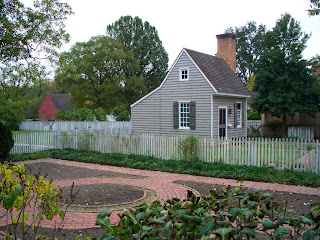This past week at the Ruppert's Bay retreat I got some big work completed. The first on my list of "things to do" was the space hungry basting of the three parts in a quilt that has to be spread out flat to accomplish, namely basting the three layers together before they can be quilted. The hand pieced top of 54 Rose-Stars was the quilt top that was ready to do this to and I got right to work. Backing laid out and stretched with painter's tape on a hard wood floor (painted red) layered with batting and finally the color filled top fit just right in the room... with a little room to walk around it on all sides. Last year I used this room to make my first machine pieced quilt. I didn't know last year to tape the bottom layer down while working which this year made the whole process much more accurate and easy. It was still hard labor to crawl on the floor stitching in large basting stitches with a long needle and thimble to push it through the three layers and back up. My figures were sore my knees and eventually my hip from laying on my bony side... But in less than 24 hours it was done folded and set aside to make way for the next project.

 |
| Rose-Star quilt basted fully stretched out on the floor of the red house's studio room |
 |
| back side of the Rose-Star Quilt is all white printed muslin. Close inspection of the photo shows lots of long dark blue threads running in a star burst from the center. |
 |
| dark blue pieces for white panels stacked waiting to be appliqued |
The Dresden Plate quilt a tribute to my great grandmother's of the same design is next. I have 30 blocks with hand stitched central circles appliqued on top of the machine pieced and appliqued plates in blue and white with opposite backgrounds. I also had seven more blocks near complete thinking I might do a small version to experiment with the machine quilting techniques I haven't tried yet with any success.
 |
| full sized diamond layout of the Dresden Plate pieces |
 |
| Diamond layout for smaller quilt top |
The new environment was stimulating and having extra room to spread out and only these two projects on my plate made a new idea pop up. Diamonds? What if I turned the blocks to the side and got a diamond pattern instead of checker board style. It looked great but then I needed half blocks to fill out a rectangle and that would be a step back on this big quilt so I decided to play with the smaller version using the diamond layout and focus on getting the original checkerboard squares laid out and sewn together. It turned out a little bigger than I expected but it fell together so well I am not complaining about extra. I spent 8 months sewing the Rose-Star pieces so I never expected to achieve in one month the machine piecing of the Blue and white project with extra blocks to spare and the green and white fence quilt still on the back burner but getting close to next... The slow hand quilting of Rose-Star will put it all back in perspective.
 |
| Queen size Dresden Plate Top seen from my back porch window laid out in the garden |
 |
| Thirty 18" inch squares appliqued with plates and center circles |
 |
| Dresden Plate Top spread on the lawn. |
After some time reading in a book on Quilting I discovered a pattern I wanted to try. This is called Seminole after the Indian tribe of Florida who developed it years ago using only a hand cranked sewing machine. It's a cool strip technique that uses stripes of three colors cut and re-sewn on diagonals in bands. The result of my first experiment is a very neat row of diamonds surrounded by contrasting color and long solid stripes... First I thought I would add some into the Dresden plate blue and white quilt but since it is so large, I think not. The better solution is to make another quilt and get really familiar with this technique. The rotary cutter, ruler and hot iron with lots of starch make this possible and fairly quick work.
 |
| first length of Seminole piecing in blues |
 |
| closer look at detail of the Seminole strip piecing |
It is very exciting to have these two projects so much closer to complete and then a new technique well underway and understood. All that thanks to the time and space provided by our great friends the Rupperts of Fairhaven Cliffs, Md. I am looking forward to playing with all this and more in the coming months as I figure out the next steps. New quilting friends at the DC Modern Quilting Guild gave me a tip to buy a "walking foot attachment" for my machine. I found one on a very sweet web page today devoted entirely to my vintage featherweight Singer sewing machine. It seems from further reading there that the sales man was right it's a highly sought after machine! This link will take you back to
the 1930s sewing shop for a little time travel. I ordered the walking foot and expect to have it in a week or two to try machine quilting again using the right foot to keep things smooth under the needle of the crawling foot.


























































